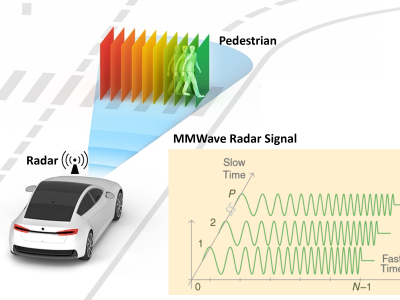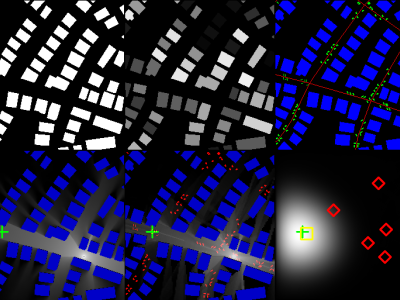CRAWDAD columbia/kinetic

- Citation Author(s):
-
Mina Cong (Columbia University)Kanghwan Kim (The Cooper Union)Maria Gorlatova (Columbia University)John Sarik (Columbia University)John Kymissis (Columbia University)Gil Zussman (Columbia University)
- Submitted by:
- CRAWDAD Team
- Last updated:
- DOI:
- 10.15783/C73W29
- Data Format:
 169 views
169 views
- Categories:
Abstract
200 hours of accelerometer information recorded over 25 days from 5 participants.
To help us better understand the properties of various energy sources and their impact on energy harvesting adaptive algorithms, we collected acceleration traces from different participants.
release date: 2014-05-13
collection environment: Measurements were collected from five participants of different ages, physiques and means of transportation to the same laboratory work location. The participants included two undergraduate students who commuted by foot as well as an undergraduate student, graduate student, and software developer who commuted by train. As mentioned earlier, the five participants were asked to carry the sensing units in a comfortable manner over a period of 25 days. The dominant motion frequency of all collected traces ran in the range of 1.92-2.8Hz, which corresponded to human walking. Using collected data, we were able to calculate the average power a harvester could generate over a trace's length as well as over a 24-hour period.
data collection methodology: For the logging of measurements, we use ADXL345 tri-axis accelerometers, Atmega328P microcontrollers and microSD cards located on SparkFun ADXL345 evaluation boards. The accelerometer sensors record acceleration along the x, y, and z axes with a 100 Hz sampling frequency. Experiments were conducted with the sensing units placed in multiple locations.
Tracesets
columbia/kinetic/kinetic-energy
200 hours of acceleration information in 25 days from 5 participants
methodology: Measurements were collected from five participants of different ages, physiques and means of transportation to the same laboratory work location. The participants included two undergraduate students who commuted by foot as well as an undergraduate student, graduate student, and software developer who commuted by train. As mentioned earlier, the five participants were asked to carry the sensing units in a comfortable manner over a period of 25 days. The dominant motion frequency of all collected traces ran in the range of 1.92-2.8 Hz, which corresponded to human walking. Using collected data, we were able to calculate the average power a harvester could generate over a trace's length as well as over a 24-hour period.
columbia/kinetic/kinetic-energy Traces
Measurements from participant 1
- columbia/kinetic/kinetic-energy/M1: Measurements were collected from five participants of different ages, physiques and means of transportation to the same laboratory work location. The participants included two undergraduate students who commuted by foot as well as an undergraduate student, graduate student, and software developer who commuted by train.
- file:M1.zip
- format: The first column is the time since the measurement started (in seconds). The second column is the acceleration along x axis (in g) . The third column is the acceleration along y axis (in g) . The fourth column is the acceleration along z axis (in g) .
Measurements from participant 2
- columbia/kinetic/kinetic-energy/M2: Measurements were collected from five participants of different ages, physiques and means of transportation to the same laboratory work location. The participants included two undergraduate students who commuted by foot as well as an undergraduate student, graduate student, and software developer who commuted by train.
- file:M2.zip
- format: The first column is the time since the measurement started (in seconds). The second column is the acceleration along x axis (in g) . The third column is the acceleration along y axis (in g) . The fourth column is the acceleration along z axis (in g) .
Measurements from participant 3
- columbia/kinetic/kinetic-energy/M3: Measurements were collected from five participants of different ages, physiques and means of transportation to the same laboratory work location. The participants included two undergraduate students who commuted by foot as well as an undergraduate student, graduate student, and software developer who commuted by train.
- file:M3.zip
- format: The first column is the time since the measurement started (in seconds). The second column is the acceleration along x axis (in g) . The third column is the acceleration along y axis (in g) . The fourth column is the acceleration along z axis (in g) .
Measurements from participant 4
- columbia/kinetic/kinetic-energy/M4: Measurements were collected from five participants of different ages, physiques and means of transportation to the same laboratory work location. The participants included two undergraduate students who commuted by foot as well as an undergraduate student, graduate student, and software developer who commuted by train.
- file:M4.zip
- format: The first column is the time since the measurement started (in seconds). The second column is the acceleration along x axis (in g) . The third column is the acceleration along y axis (in g) . The fourth column is the acceleration along z axis (in g) .
Measurements from participant 5
- columbia/kinetic/kinetic-energy/M5: Measurements were collected from five participants of different ages, physiques and means of transportation to the same laboratory work location. The participants included two undergraduate students who commuted by foot as well as an undergraduate student, graduate student, and software developer who commuted by train.
- file:M5.zip
- format: The first column is the time since the measurement started (in seconds). The second column is the acceleration along x axis (in g) . The third column is the acceleration along y axis (in g) . The fourth column is the acceleration along z axis (in g) .
Instructions:
The files in this directory are a CRAWDAD dataset hosted by IEEE DataPort.
About CRAWDAD: the Community Resource for Archiving Wireless Data At Dartmouth is a data resource for the research community interested in wireless networks and mobile computing.
CRAWDAD was founded at Dartmouth College in 2004, led by Tristan Henderson, David Kotz, and Chris McDonald. CRAWDAD datasets are hosted by IEEE DataPort as of November 2022.
Note: Please use the Data in an ethical and responsible way with the aim of doing no harm to any person or entity for the benefit of society at large. Please respect the privacy of any human subjects whose wireless-network activity is captured by the Data and comply with all applicable laws, including without limitation such applicable laws pertaining to the protection of personal information, security of data, and data breaches. Please do not apply, adapt or develop algorithms for the extraction of the true identity of users and other information of a personal nature, which might constitute personally identifiable information or protected health information under any such applicable laws. Do not publish or otherwise disclose to any other person or entity any information that constitutes personally identifiable information or protected health information under any such applicable laws derived from the Data through manual or automated techniques.
Please acknowledge the source of the Data in any publications or presentations reporting use of this Data.
Citation:
Mina Cong, Kanghwan Kim, Maria Gorlatova, John Sarik, John Kymissis, Gil Zussman, columbia/kinetic, https://doi.org/10.15783/C73W29 , Date: 20140513
















